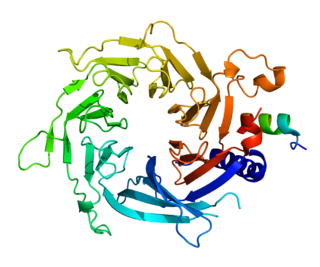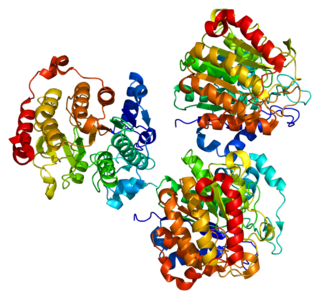Histone deacetylase 3 is an enzyme encoded by the HDAC3 gene in both humans and mice. [5] [6] [7] [8]
Histone deacetylase 3 is an enzyme encoded by the HDAC3 gene in both humans and mice. [5] [6] [7] [8]
Histones are highly alkaline proteins that package and order DNA into structural units called nucleosomes, which comprise the major protein component of chromatin. The posttranslational and enzymatically mediated lysine acetylation and deacetylation of histone tails change the local chromatin structure by altering the electrostatic attraction between the negatively charged DNA backbone and histones. HDAC3 is a Class I member of the histone deacetylase superfamily (comprising four classes based on function and DNA sequence homology) that is recruited to enhancers to modulate both the epigenome and nearby gene expression. HDAC3 is found exclusively in the cell nucleus, where it is the sole endogenous histone deacetylase biochemically purified in the nuclear-receptor corepressor complex containing NCOR and SMRT (NCOR2). Thus, HDAC3, unlike other HDACs, has a unique role in modulating the transcriptional activities of nuclear receptors.
Histone deacetylases can be regulated by endogenous factors, dietary components, synthetic inhibitors and bacteria-derived signals. Studies in mice with a specific deletion of HDAC3 in intestinal epithelial cells (IECs) show a deregulated IEC's gene expression. In these deletion-mutant mice, loss of Paneth cells, impaired IEC function and alterations in intestinal composition of commensal bacteria were observed. These negative effects were not observed in germ-free mice, indicating that the effects of the deletion are only seen in the presence of intestinal microbial colonization. But the negative effects of HDAC3 deletion are not due to the presence of an altered microbiota because normal germ-free mice colonized with the altered microbiota did not show the negative effects seen in deletion mutants.
Although the precise mechanism and the specific signals are not known it is clear that HDAC3 interacts with derived signals of commensal bacteria of the gut microbiota. These interactions are responsible of calibrating epithelial cells responses necessary to establish a normal relationship between the host and the commensal as well as to maintain intestinal homeostasis. [9] [10] [11] [12]
HDAC3 has been shown to interact with:

Histone acetyltransferase p300 also known as p300 HAT or E1A-associated protein p300 also known as EP300 or p300 is an enzyme that, in humans, is encoded by the EP300 gene. It functions as histone acetyltransferase that regulates transcription of genes via chromatin remodeling by allowing histone proteins to wrap DNA less tightly. This enzyme plays an essential role in regulating cell growth and division, prompting cells to mature and assume specialized functions (differentiate), and preventing the growth of cancerous tumors. The p300 protein appears to be critical for normal development before and after birth.
In molecular biology and genetics, transcription coregulators are proteins that interact with transcription factors to either activate or repress the transcription of specific genes. Transcription coregulators that activate gene transcription are referred to as coactivators while those that repress are known as corepressors. The mechanism of action of transcription coregulators is to modify chromatin structure and thereby make the associated DNA more or less accessible to transcription. In humans several dozen to several hundred coregulators are known, depending on the level of confidence with which the characterisation of a protein as a coregulator can be made. One class of transcription coregulators modifies chromatin structure through covalent modification of histones. A second ATP dependent class modifies the conformation of chromatin.

Histone deacetylase 1 (HDAC1) is an enzyme that in humans is encoded by the HDAC1 gene.

The nuclear receptor co-repressor 1 also known as thyroid-hormone- and retinoic-acid-receptor-associated co-repressor 1 (TRAC-1) is a protein that in humans is encoded by the NCOR1 gene.

The nuclear receptor co-repressor 2 (NCOR2) is a transcriptional coregulatory protein that contains several nuclear receptor-interacting domains. In addition, NCOR2 appears to recruit histone deacetylases to DNA promoter regions. Hence NCOR2 assists nuclear receptors in the down regulation of target gene expression. NCOR2 is also referred to as a silencing mediator for retinoid or thyroid-hormone receptors (SMRT) or T3 receptor-associating cofactor 1 (TRAC-1).

In genetics and molecular biology, a corepressor is a molecule that represses the expression of genes. In prokaryotes, corepressors are small molecules whereas in eukaryotes, corepressors are proteins. A corepressor does not directly bind to DNA, but instead indirectly regulates gene expression by binding to repressors.

Histone deacetylase 2 (HDAC2) is an enzyme that in humans is encoded by the HDAC2 gene. It belongs to the histone deacetylase class of enzymes responsible for the removal of acetyl groups from lysine residues at the N-terminal region of the core histones. As such, it plays an important role in gene expression by facilitating the formation of transcription repressor complexes and for this reason is often considered an important target for cancer therapy.

Paired amphipathic helix protein Sin3a is a protein that in humans is encoded by the SIN3A gene.

Histone-binding protein RBBP4 is a protein that in humans is encoded by the RBBP4 gene.

Histone deacetylase 4, also known as HDAC4, is a protein that in humans is encoded by the HDAC4 gene.

Histone-binding protein RBBP7 is a protein that in humans is encoded by the RBBP7 gene.

The testicular receptor 2 (TR2) also known as NR2C1 is protein that in humans is encoded by the NR2C1 gene. TR2 is a member of the nuclear receptor family of transcription factors.

C-terminal-binding protein 1 also known as CtBP1 is a protein that in humans is encoded by the CTBP1 gene. CtBP1 is one of two CtBP proteins, the other protein being CtBP2.

Myocyte-specific enhancer factor 2A is a protein that in humans is encoded by the MEF2A gene. MEF2A is a transcription factor in the Mef2 family. In humans it is located on chromosome 15q26. Certain mutations in MEF2A cause an autosomal dominant form of coronary artery disease and myocardial infarction.

Histone deacetylase 5 is an enzyme that in humans is encoded by the HDAC5 gene.

Histone deacetylase 9 is an enzyme that in humans is encoded by the HDAC9 gene.

Histone deacetylase 7 is an enzyme that in humans is encoded by the HDAC7 gene.

Sin3A-associated protein, 30kDa, also known as SAP30, is a protein which in humans is encoded by the SAP30 gene.

Transducin (beta)-like 1X-linked, also known as TBL1X, is a protein which in humans is encoded by the TBL1X gene.
Nuclear receptor coregulators are a class of transcription coregulators that have been shown to be involved in any aspect of signaling by any member of the nuclear receptor superfamily. A comprehensive database of coregulators for nuclear receptors and other transcription factors was previously maintained at the Nuclear Receptor Signaling Atlas website which has since been replaced by the Signaling Pathways Project website.
This article incorporates text from the United States National Library of Medicine, which is in the public domain.